Unit 6 Is this your pencil Section A 导学案(含答案)
文档属性
| 名称 | Unit 6 Is this your pencil Section A 导学案(含答案) |
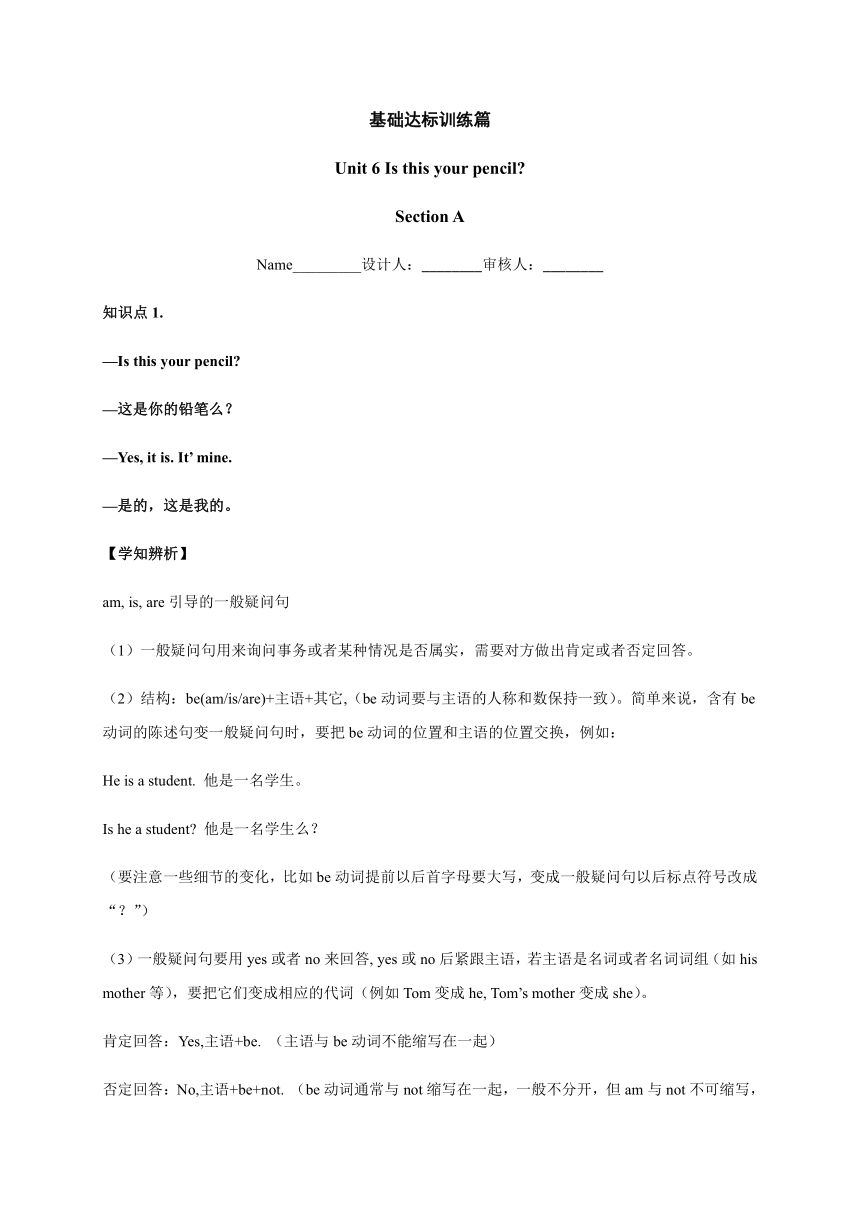
|
|
| 格式 | docx | ||
| 文件大小 | 33.2KB | ||
| 资源类型 | 教案 | ||
| 版本资源 | 鲁教版 | ||
| 科目 | 英语 | ||
| 更新时间 | 2022-08-31 17:46:12 | ||
图片预览

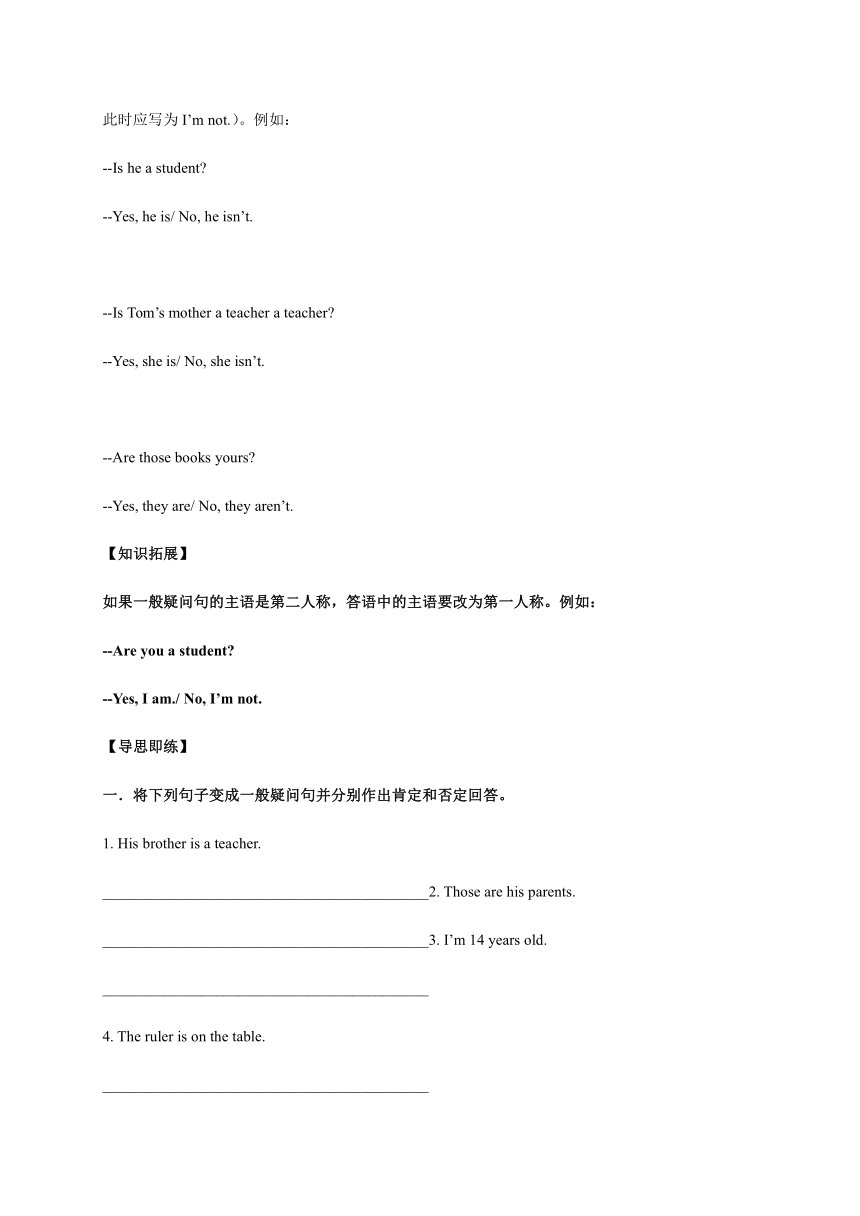
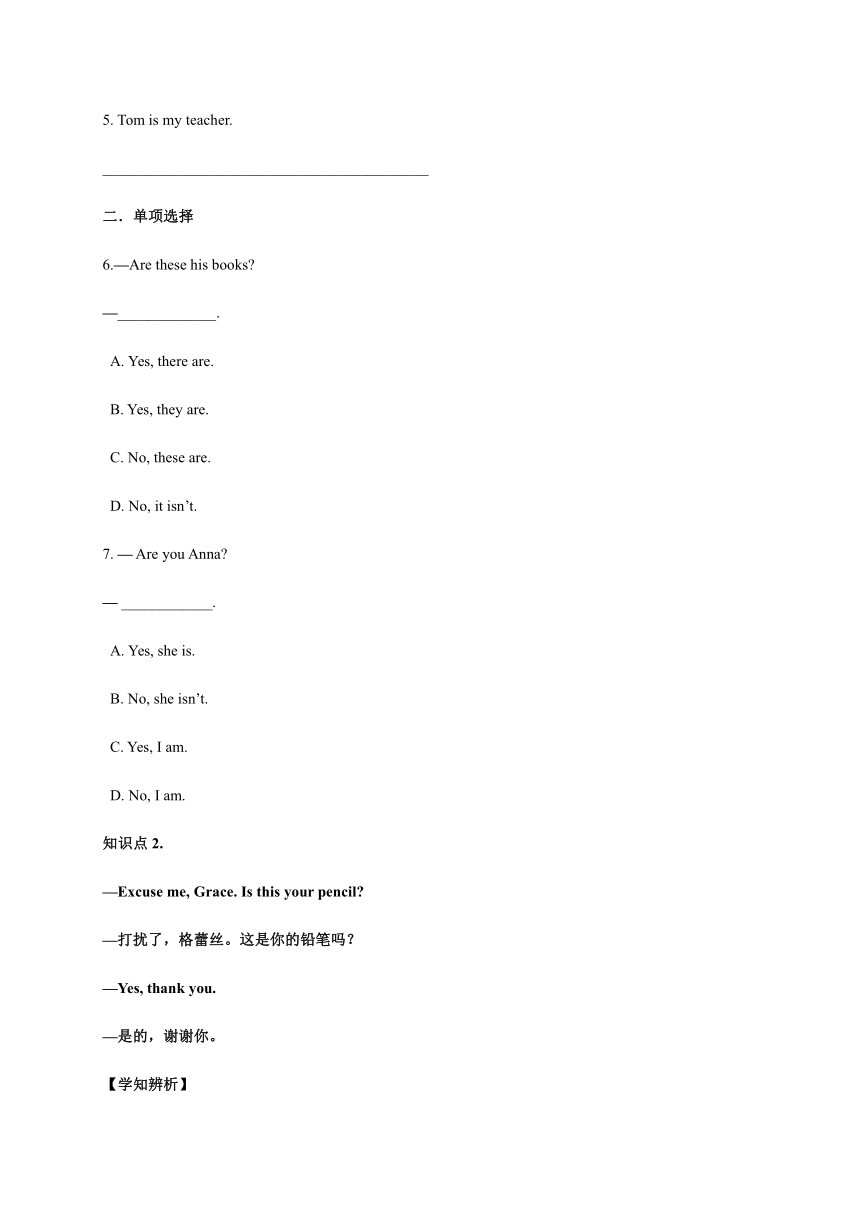
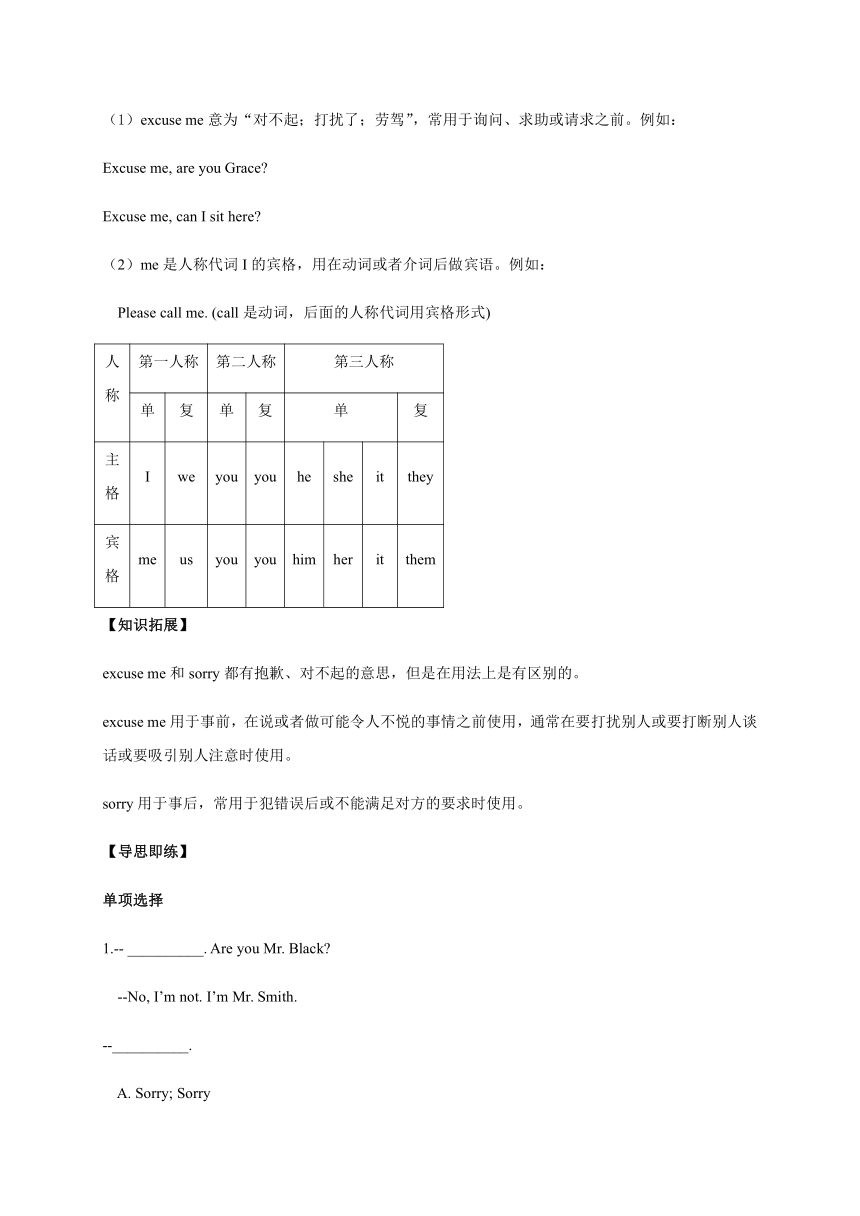
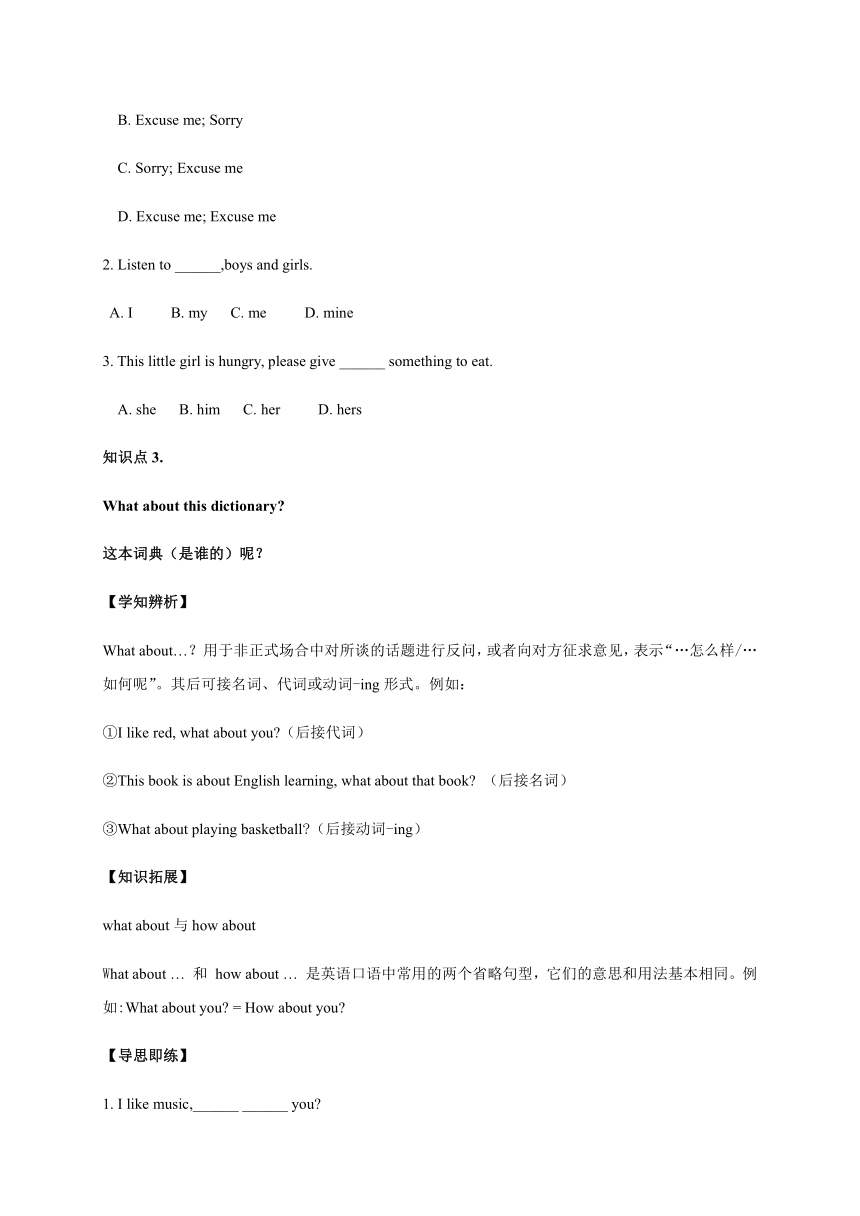
文档简介
基础达标训练篇
Unit 6 Is this your pencil
Section A
Name_________设计人:________审核人:________
知识点1.
—Is this your pencil
—这是你的铅笔么?
—Yes, it is. It’ mine.
—是的,这是我的。
【学知辨析】
am, is, are引导的一般疑问句
(1)一般疑问句用来询问事务或者某种情况是否属实,需要对方做出肯定或者否定回答。
(2)结构:be(am/is/are)+主语+其它,(be动词要与主语的人称和数保持一致)。简单来说,含有be动词的陈述句变一般疑问句时,要把be动词的位置和主语的位置交换,例如:
He is a student. 他是一名学生。
Is he a student 他是一名学生么?
(要注意一些细节的变化,比如be动词提前以后首字母要大写,变成一般疑问句以后标点符号改成“?”)
(3)一般疑问句要用yes或者no来回答, yes或no后紧跟主语,若主语是名词或者名词词组(如his mother等),要把它们变成相应的代词(例如Tom变成he, Tom’s mother变成she)。
肯定回答:Yes,主语+be. (主语与be动词不能缩写在一起)
否定回答:No,主语+be+not. (be动词通常与not缩写在一起,一般不分开,但am与not不可缩写,此时应写为I’m not.)。例如:
--Is he a student
--Yes, he is/ No, he isn’t.
--Is Tom’s mother a teacher a teacher
--Yes, she is/ No, she isn’t.
--Are those books yours
--Yes, they are/ No, they aren’t.
【知识拓展】
如果一般疑问句的主语是第二人称,答语中的主语要改为第一人称。例如:
--Are you a student
--Yes, I am./ No, I’m not.
【导思即练】
一.将下列句子变成一般疑问句并分别作出肯定和否定回答。
1. His brother is a teacher.
___________________________________________2. Those are his parents.
___________________________________________3. I’m 14 years old.
___________________________________________
4. The ruler is on the table.
___________________________________________
5. Tom is my teacher.
___________________________________________
二.单项选择
6.—Are these his books
—_____________.
A. Yes, there are.
B. Yes, they are.
C. No, these are.
D. No, it isn’t.
7. — Are you Anna
— ____________.
A. Yes, she is.
B. No, she isn’t.
C. Yes, I am.
D. No, I am.
知识点2.
—Excuse me, Grace. Is this your pencil
—打扰了,格蕾丝。这是你的铅笔吗?
—Yes, thank you.
—是的,谢谢你。
【学知辨析】
excuse me意为“对不起;打扰了;劳驾”,常用于询问、求助或请求之前。例如:
Excuse me, are you Grace
Excuse me, can I sit here
me是人称代词I的宾格,用在动词或者介词后做宾语。例如:
Please call me. (call是动词,后面的人称代词用宾格形式)
人称 第一人称 第二人称 第三人称
单 复 单 复 单 复
主格 I we you you he she it they
宾格 me us you you him her it them
【知识拓展】
excuse me和sorry都有抱歉、对不起的意思,但是在用法上是有区别的。
excuse me用于事前,在说或者做可能令人不悦的事情之前使用,通常在要打扰别人或要打断别人谈话或要吸引别人注意时使用。
sorry用于事后,常用于犯错误后或不能满足对方的要求时使用。
【导思即练】
单项选择
-- __________. Are you Mr. Black
--No, I’m not. I’m Mr. Smith.
--__________.
A. Sorry; Sorry
B. Excuse me; Sorry
C. Sorry; Excuse me
D. Excuse me; Excuse me
2. Listen to ______,boys and girls.
A. I B. my C. me D. mine
3. This little girl is hungry, please give ______ something to eat.
A. she B. him C. her D. hers
知识点3.
What about this dictionary
这本词典(是谁的)呢?
【学知辨析】
What about…?用于非正式场合中对所谈的话题进行反问,或者向对方征求意见,表示“…怎么样/…如何呢”。其后可接名词、代词或动词-ing形式。例如:
①I like red, what about you (后接代词)
②This book is about English learning, what about that book (后接名词)
③What about playing basketball (后接动词-ing)
【知识拓展】
what about与how about
What about … 和 how about … 是英语口语中常用的两个省略句型,它们的意思和用法基本相同。例如:What about you = How about you
【导思即练】
1. I like music,______ ______ you
2. I don’t want to play computer games, what about _______ soccer
A. play B. to play
C. playing D. plays
3. I don’t like the green bag, _______ the yellow one
A. What’s B. How
C. What about D. How’s
知识点4.
—Thank you for your help, Anna
—多谢你的帮助,安娜。
—You’re welcome.
—不用客气。
【学知辨析】
1.thank you for…表示“因…而感谢”,for是介词,后面可跟名词或者动名词(动词-ing)。thank you= thanks, 因此thank you for…也可以说thanks for…。例如:
Thank you for your computer.
Thanks for helping me.
2.You're welcome用于回答别人的感谢,是别客气、不用谢的意思。
【知识拓展】
1.当别人致谢时,除了you’re welcome,我们还可以回答My pleasure/ It’s a pleasure/That’s OK/ Not at all等等。
2.welcome在此处为形容词,意为“受欢迎的”。它还可以用做动词,意为“欢迎”,如:Welcome to our school.
【导思即练】
一、单项选择
1.--Thank you.
--___________.
A. No thanks. B. Excuse me.
C. OK. D. You’re welcome.
2. --Your English is very good.
--___________.
A. OK B. Just so so.
C. All right D. Thank you.
知识点5.
No, they’re Bob’s. 不,它们是鲍勃的。
【学知辨析】
Bob’s意为鲍勃的,为名词所有格形式,表示有生命的名词的所属关系,这种名词所有格的构成方法为:
①一般情况直接在名词后面加“’s”,例如:
Tom’s book 汤姆的书
my father’s car 我父亲的汽车
Children’s Day 儿童节
②以s结尾的单数或复数名词,直接在后面加“’”,不需要再加s。例如:
my brothers’ room 我哥哥们的房间
Teachers’ Day 教师节
【知识拓展】
若同一样东西为两人共有,则仅后面的名词用所有格,例如:
This is Tom and Jim's room.(这是汤姆和吉姆共有的房间)
如果不是两人共有,而是各有各的,则两个名词都用所有格,且其后名词应为复数。
例如:
These are Tom's and Jim's rooms.(这是汤姆和杰森各自的房间)
【导思即练】
1. Today is September 10th. It's _____ Day.
A. Teacher B. Teacher's C. Teachers' D. Teacher'
2. It's June 1st, it's _____ Day.
A. Childrens B. Children's
C. Childrens' D. Childrens's
3. This year, _____ is on May 9th.
A. my mother's birthday
B. my mothers' birthday
C. my mothers birthday
D. my mothers's birthday
4. This is ___ ball. It's not ___ .
A. the boy's, girl's B. the boy's, the girl's
C. the boy, the girl D. boys', girls
知识点6.
名词性物主代词
形容词性物主代词 名词性物主代词
单数 复数 单数 复数
第一人称 my our mine ours
第二人称 your your yours yours
第三人称 his their his theirs
her hers
its its
【学知辨析】
1.形容词性物主代词相当于一个形容词,其后必须跟名词,相当于一个定语。例如:
This is my book.
Those are your books.
2.名词性物主代词相当于一个名词,单独使用,在句中可做主语、表语或者宾语,后面不能再跟名词。例如:
My pen is yellow, but yours is blue.
3.名词性物主代词=形容词行物主代词+名词(或名词短语)。例如:
This is not my schoolbag, mine is black.
例句中,mine就等同于my bag。
4.一个最简单的区别方法:后面是名词的话,前面就要用形容词性物主代词。后面没有名词的话,就用名词性物主代词。
【知识拓展】
1.如果名词前用了形容词性物主代词,就不能再用冠词(a, an, the)、 指示代词(this, that, these, those)等修饰词了。例如: 这是他的书桌。This is his desk.
2.在使用名词性物主代词时,必须有特定的语言环境,也就是要省略的名词大家已经知道,前文已经提起过。例如:
There is a book. It’s hers. 那有本书。是她的。(根据前文,我们知道hers=her book)
【导思即练】
一.用括号中单词的适当形式填空
1. He is_________ (our/ours) English teacher. _________(he) name is Sam(男人名).
2. This isn’t_______ ( I ) book. ________(my) is in the bag.
3. This bike is my sister’s. It is not________(he).
4.—Are these___________(you) pencils?
—Yes, they are_________(our).
5.—Whose pencil is this
—It’s_________( she ).
二、单项选择
6. __ bag is new and __ is new, too.
A. Our, he B. Ours, his
C. My, his D. My, her
7. This room is ours, and that one is __.
A. they B. them
C. their D. theirs
8. --Whose pencils are there
--They’re __.
A. my B. me
C. mine D. our
9. --Is the new watch __
--Yes, it’s __.
A. you, me B. yours, mine
C. your, my D. your, mine
基础达标训练篇
Unit 6 Is this your pencil
Section A
知识点1
【导思即练】
1. Is your brother a teacher Yes, he is. / No, he isn’t.
2. Are those his parents Yes, they are. / No, they aren’t.
3. Are you 14 years old Yes, I am./ No, I’m not.
4. Is the ruler on the table Yes, it is. / No, it isn’t.
5. Is Tom your teacher Yes, he is. / No, he isn’t.
6. B 7. C.
知识点2
【导思即练】1.B 2. C 3. C
知识点3
【导思即练】1. What about 2. C 3. C
知识点4
【导思即练】1.D 2. D
知识点5
【导思即练】1.C 2.B 3.A 4.B
知识点6
【导思即练】1.our; His 2. my; Mine 3. his
4. your; ours 5.hers 6-9 C D C B
Unit 6 Is this your pencil
Section A
Name_________设计人:________审核人:________
知识点1.
—Is this your pencil
—这是你的铅笔么?
—Yes, it is. It’ mine.
—是的,这是我的。
【学知辨析】
am, is, are引导的一般疑问句
(1)一般疑问句用来询问事务或者某种情况是否属实,需要对方做出肯定或者否定回答。
(2)结构:be(am/is/are)+主语+其它,(be动词要与主语的人称和数保持一致)。简单来说,含有be动词的陈述句变一般疑问句时,要把be动词的位置和主语的位置交换,例如:
He is a student. 他是一名学生。
Is he a student 他是一名学生么?
(要注意一些细节的变化,比如be动词提前以后首字母要大写,变成一般疑问句以后标点符号改成“?”)
(3)一般疑问句要用yes或者no来回答, yes或no后紧跟主语,若主语是名词或者名词词组(如his mother等),要把它们变成相应的代词(例如Tom变成he, Tom’s mother变成she)。
肯定回答:Yes,主语+be. (主语与be动词不能缩写在一起)
否定回答:No,主语+be+not. (be动词通常与not缩写在一起,一般不分开,但am与not不可缩写,此时应写为I’m not.)。例如:
--Is he a student
--Yes, he is/ No, he isn’t.
--Is Tom’s mother a teacher a teacher
--Yes, she is/ No, she isn’t.
--Are those books yours
--Yes, they are/ No, they aren’t.
【知识拓展】
如果一般疑问句的主语是第二人称,答语中的主语要改为第一人称。例如:
--Are you a student
--Yes, I am./ No, I’m not.
【导思即练】
一.将下列句子变成一般疑问句并分别作出肯定和否定回答。
1. His brother is a teacher.
___________________________________________2. Those are his parents.
___________________________________________3. I’m 14 years old.
___________________________________________
4. The ruler is on the table.
___________________________________________
5. Tom is my teacher.
___________________________________________
二.单项选择
6.—Are these his books
—_____________.
A. Yes, there are.
B. Yes, they are.
C. No, these are.
D. No, it isn’t.
7. — Are you Anna
— ____________.
A. Yes, she is.
B. No, she isn’t.
C. Yes, I am.
D. No, I am.
知识点2.
—Excuse me, Grace. Is this your pencil
—打扰了,格蕾丝。这是你的铅笔吗?
—Yes, thank you.
—是的,谢谢你。
【学知辨析】
excuse me意为“对不起;打扰了;劳驾”,常用于询问、求助或请求之前。例如:
Excuse me, are you Grace
Excuse me, can I sit here
me是人称代词I的宾格,用在动词或者介词后做宾语。例如:
Please call me. (call是动词,后面的人称代词用宾格形式)
人称 第一人称 第二人称 第三人称
单 复 单 复 单 复
主格 I we you you he she it they
宾格 me us you you him her it them
【知识拓展】
excuse me和sorry都有抱歉、对不起的意思,但是在用法上是有区别的。
excuse me用于事前,在说或者做可能令人不悦的事情之前使用,通常在要打扰别人或要打断别人谈话或要吸引别人注意时使用。
sorry用于事后,常用于犯错误后或不能满足对方的要求时使用。
【导思即练】
单项选择
-- __________. Are you Mr. Black
--No, I’m not. I’m Mr. Smith.
--__________.
A. Sorry; Sorry
B. Excuse me; Sorry
C. Sorry; Excuse me
D. Excuse me; Excuse me
2. Listen to ______,boys and girls.
A. I B. my C. me D. mine
3. This little girl is hungry, please give ______ something to eat.
A. she B. him C. her D. hers
知识点3.
What about this dictionary
这本词典(是谁的)呢?
【学知辨析】
What about…?用于非正式场合中对所谈的话题进行反问,或者向对方征求意见,表示“…怎么样/…如何呢”。其后可接名词、代词或动词-ing形式。例如:
①I like red, what about you (后接代词)
②This book is about English learning, what about that book (后接名词)
③What about playing basketball (后接动词-ing)
【知识拓展】
what about与how about
What about … 和 how about … 是英语口语中常用的两个省略句型,它们的意思和用法基本相同。例如:What about you = How about you
【导思即练】
1. I like music,______ ______ you
2. I don’t want to play computer games, what about _______ soccer
A. play B. to play
C. playing D. plays
3. I don’t like the green bag, _______ the yellow one
A. What’s B. How
C. What about D. How’s
知识点4.
—Thank you for your help, Anna
—多谢你的帮助,安娜。
—You’re welcome.
—不用客气。
【学知辨析】
1.thank you for…表示“因…而感谢”,for是介词,后面可跟名词或者动名词(动词-ing)。thank you= thanks, 因此thank you for…也可以说thanks for…。例如:
Thank you for your computer.
Thanks for helping me.
2.You're welcome用于回答别人的感谢,是别客气、不用谢的意思。
【知识拓展】
1.当别人致谢时,除了you’re welcome,我们还可以回答My pleasure/ It’s a pleasure/That’s OK/ Not at all等等。
2.welcome在此处为形容词,意为“受欢迎的”。它还可以用做动词,意为“欢迎”,如:Welcome to our school.
【导思即练】
一、单项选择
1.--Thank you.
--___________.
A. No thanks. B. Excuse me.
C. OK. D. You’re welcome.
2. --Your English is very good.
--___________.
A. OK B. Just so so.
C. All right D. Thank you.
知识点5.
No, they’re Bob’s. 不,它们是鲍勃的。
【学知辨析】
Bob’s意为鲍勃的,为名词所有格形式,表示有生命的名词的所属关系,这种名词所有格的构成方法为:
①一般情况直接在名词后面加“’s”,例如:
Tom’s book 汤姆的书
my father’s car 我父亲的汽车
Children’s Day 儿童节
②以s结尾的单数或复数名词,直接在后面加“’”,不需要再加s。例如:
my brothers’ room 我哥哥们的房间
Teachers’ Day 教师节
【知识拓展】
若同一样东西为两人共有,则仅后面的名词用所有格,例如:
This is Tom and Jim's room.(这是汤姆和吉姆共有的房间)
如果不是两人共有,而是各有各的,则两个名词都用所有格,且其后名词应为复数。
例如:
These are Tom's and Jim's rooms.(这是汤姆和杰森各自的房间)
【导思即练】
1. Today is September 10th. It's _____ Day.
A. Teacher B. Teacher's C. Teachers' D. Teacher'
2. It's June 1st, it's _____ Day.
A. Childrens B. Children's
C. Childrens' D. Childrens's
3. This year, _____ is on May 9th.
A. my mother's birthday
B. my mothers' birthday
C. my mothers birthday
D. my mothers's birthday
4. This is ___ ball. It's not ___ .
A. the boy's, girl's B. the boy's, the girl's
C. the boy, the girl D. boys', girls
知识点6.
名词性物主代词
形容词性物主代词 名词性物主代词
单数 复数 单数 复数
第一人称 my our mine ours
第二人称 your your yours yours
第三人称 his their his theirs
her hers
its its
【学知辨析】
1.形容词性物主代词相当于一个形容词,其后必须跟名词,相当于一个定语。例如:
This is my book.
Those are your books.
2.名词性物主代词相当于一个名词,单独使用,在句中可做主语、表语或者宾语,后面不能再跟名词。例如:
My pen is yellow, but yours is blue.
3.名词性物主代词=形容词行物主代词+名词(或名词短语)。例如:
This is not my schoolbag, mine is black.
例句中,mine就等同于my bag。
4.一个最简单的区别方法:后面是名词的话,前面就要用形容词性物主代词。后面没有名词的话,就用名词性物主代词。
【知识拓展】
1.如果名词前用了形容词性物主代词,就不能再用冠词(a, an, the)、 指示代词(this, that, these, those)等修饰词了。例如: 这是他的书桌。This is his desk.
2.在使用名词性物主代词时,必须有特定的语言环境,也就是要省略的名词大家已经知道,前文已经提起过。例如:
There is a book. It’s hers. 那有本书。是她的。(根据前文,我们知道hers=her book)
【导思即练】
一.用括号中单词的适当形式填空
1. He is_________ (our/ours) English teacher. _________(he) name is Sam(男人名).
2. This isn’t_______ ( I ) book. ________(my) is in the bag.
3. This bike is my sister’s. It is not________(he).
4.—Are these___________(you) pencils?
—Yes, they are_________(our).
5.—Whose pencil is this
—It’s_________( she ).
二、单项选择
6. __ bag is new and __ is new, too.
A. Our, he B. Ours, his
C. My, his D. My, her
7. This room is ours, and that one is __.
A. they B. them
C. their D. theirs
8. --Whose pencils are there
--They’re __.
A. my B. me
C. mine D. our
9. --Is the new watch __
--Yes, it’s __.
A. you, me B. yours, mine
C. your, my D. your, mine
基础达标训练篇
Unit 6 Is this your pencil
Section A
知识点1
【导思即练】
1. Is your brother a teacher Yes, he is. / No, he isn’t.
2. Are those his parents Yes, they are. / No, they aren’t.
3. Are you 14 years old Yes, I am./ No, I’m not.
4. Is the ruler on the table Yes, it is. / No, it isn’t.
5. Is Tom your teacher Yes, he is. / No, he isn’t.
6. B 7. C.
知识点2
【导思即练】1.B 2. C 3. C
知识点3
【导思即练】1. What about 2. C 3. C
知识点4
【导思即练】1.D 2. D
知识点5
【导思即练】1.C 2.B 3.A 4.B
知识点6
【导思即练】1.our; His 2. my; Mine 3. his
4. your; ours 5.hers 6-9 C D C B
同课章节目录
- Unit 1 Good morning
- Section A
- Section B
- Unit 2 What's this in English?
- Section A
- Section B
- Unit 3 What color is it?
- Section A
- Section B
- Unit 4 My name's is Gina
- Section A
- Section B
- Unit 5 This is my siste
- Section A
- Section B
- Unit 6 Is this your pencil?
- Section A
- Section B
- Unit 7 Where's my schoolbag?
- Section A
- Section B
- Unit 8 Do you have a soccer ball?
- Sectioan A
- Sectioan B
- Unit 9 Do you like bananas?
- Section A
- Section B
- Unit 10 How much are these socks?
- Section A
- Section B
